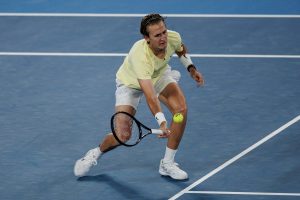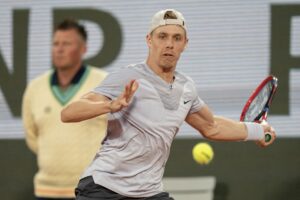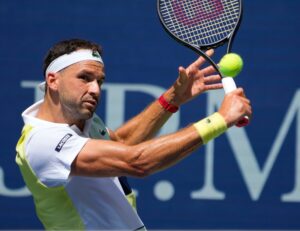As Juan Martin Del Potro prepares to face Rafael Nadal, we look at his career–from young prodigy, to tragic figure, to comeback king and national hero–and consider his chances against the world #1.
This US Open has had its fair share of heart-warming comeback stories. Semi-finalist Sloane Stephens, who was sidelined for ten months after foot surgery; Petra Kvitova, who was stabbed in her playing hand in her home less than nine months ago; Venus Williams, who has battled back to the Top 5 despite being diagnosed with an auto immune disease in 2011.
But while all are stories of ardour and pain, few have suffered a comeback trail as long as Juan Martin Del Potro’s.
The 2009 US Open final. 20-year-old Del Potro stuns the tennis world with a five-set victory over Roger Federer, halting the 15-time Grand Slam champion’s 41-match winning streak in Flushing Meadows. The 6’6″ Argentine did what many expected of Alexander Zverev this year–bullying his way to the title with a hammer blow forehand and a crushing first serve. In the semi-finals, he delivered Rafael Nadal one of the soundest thrashings of his career. In the land of opportunity, the world had well and truly become his oyster.
But like a true Shakespearean tragedy, triumph was quickly followed by disaster. A wrist injury, the tennis player’s most dreaded hamartia, forced the World #4 off the tour after the Australian Open, and that May he took the poisoned chalice of surgery.
In 2011, after plummeting to #485 in the world, Del Potro moved back to the top of the game, scooping up the accolade of ATP Comeback Player of the Year. An Olympic bronze, 10 ATP titles, and a return to the top 5 followed.
Yet, agonisingly, that was not the end of the Argentine’s woes. Wrist trouble had been lurking, Iago-like, throughout Del Potro’s semi-renaissance, and he required another operation in February 2014.
Two more operations followed, meaning the Argentine played only 14 matches in 2014 and 2015. Del Potro, once a giant of the game, had reached his nadir.
On his injury, he spoke with the same touching ingenuousness that had won New York’s heart six years prior.
“Injuries are the worst thing that can happen in the life of an athlete,” he said in an interview with Vorterix Radio in February 2015. “In the last years, I’ve felt like my life had lots of ups and downs—at some point, I could go back to my best ranking, and then again things changed because of an injury and all the bad things came back. And that’s how these last years have been for me. It hasn’t been easy. It’s not easy to live with an injury that pulls you away from the courts for so long. It’s the hardest match I’ve ever played. It tires you physically, it wears you out mentally, it fills you with fear, doubts, and uncertainty. You wake up every day thinking, ‘Will this be the end of my career?’”
“But today I feel very strong—I won’t give up because of this. I know this is a big rock in my road, but I’m really trying. I have great desire to play again […] all this time I was out I had a really bad time—I cried a lot. It’s truly ugly to watch on TV, to see that the big tournaments are opening up, and the big names winning Grand Slams are starting to change, and me feeling like I could be there and not being able to compete […] It’s really hard. But, well, I had to go through this and I have to be strong now. After this, just by playing again, I will be happy and I’m going to enjoy it a lot.”
But in 2016, Del Potro was able to make his return, and he rapidly became sport’s feel good story of the year. Playing with the fearlessness of a man simply grateful to be holding a tennis racket again, he battled his way to a silver medal in Rio, defeating Nadal in the semi-finals before losing to Andy Murray in a spectacular four hour marathon. He then reached the last eight of the US Open as a wild card, before coming back from two sets down against Marin Cilic to clinch Argentina’s first ever Davis Cup title.
In truth, it has not been a fairy tale ten months since then. A return to the top 30, but no ATP titles, an early exit from Wimbledon and, before the US Open, only one top 10 victory to his name in 2017. But now, Del Potro has the chance to repeat his heroics of 2009 and turn tragedy into a true fairy tale.
“Well, I can’t believe that I’m play [sic] another semi-final after all my injuries, after all my surgeries,” the Argentine admitted after defeating Roger Federer, with that gracious humility that has earned him the title of “gentle giant.” “Especially to play here in New York, which is my favourite tournament and my favourite city in which to play tennis.” No sooner had he finished than the familiar chants of “Delpo” filled the Arthur Ashe stadium. His reply to the vocal Argentinian contingent roughly translated as, “Thank you from the bottom of my heart.”
Del Potro is a man hard not to get teary-eyed over. But let’s cut the sentimentality and consider the big man’s chances against World #1 and two-time US Open champion Rafael Nadal.
While the Spaniard leads the head to head 8-5, Del Potro has the edge on hard courts with a slim 5-4 lead. Their most recent meeting came in the semi-finals of the Rio Olympics, the Argentine battling past an albeit misfiring Nadal 5-7 6-4 7-6(5). But, equally, half of Nadal’s victories came when Del Potro was hardly at the height of his powers in 2011.
Jason Fernandes’ review of Nadal and Del Potro’s five best clashes
Del Potro is certainly in the mould of Nadal’s famous conquerors. Lukas Rosol, Gilles Muller, Stan Wawrinka, and more recently Denis Shapovalov and Nick Kyrgios–they have all had the power to press high up the court and take Nadal’s leaping groundstrokes early. The Spaniard has looked helpless, even lightweight, in the face of such an onslaught, moving further and further behind the baseline and sinking into passivity. Del Potro undoubtedly has the physicality to implement such a strategy, and he enjoys high balls to his forehand flank. His epic against Dominic Thiem has also certainly given him chance to cut his teeth against a clay court baseliner.
After four bouts of wrist surgery, the 28-year-old’s backhand is far from the force it once was–a flat, shoveling stroke compared to the hammer blow of his forehand side. Federer’s downfall was failing to consistently avoid the Del Potro forehand, his misfiring one-handed backhand too often landing centrally. As a left-hander, Nadal’s bread and butter shot, his crosscourt forehand, will naturally pin Del Potro onto his backhand side. The Spaniard is also serving far better; he has made 69% of first serves over his past three matches. It will be difficult for Del Potro to get a foothold in Nadal’s service games.
Amy Lundy’s look at the Argentine’s backhand stroke
There is also the small matter of Del Potro’s fitness. While there seemed to be no concerns on Wednesday, Nadal’s bullying physicality will provide a far sterner examination of the Argentine’s condition. “I think I am recovering well,” he commented. “I did what the doctor says, all the treatments, and I played just free [against Federer]. Now is still a harder match. I like to play against him [Rafael Nadal] when I’m in good conditions. But it’s not the case at this moment. For sure I will try to make winners with my forehands and don’t run too much, because my legs are tired.” In truth, the laconic Argentine always looks dead on his feet between points, trudging, sloth-like, along the baseline. But on Monday the concerns were very real, Del Potro having failed to shake off a bout of flu.
Nadal has been as imperious in the past two rounds as he looked shaky in the first three. The World #1 totally outmuscled Alexandr Dolgopolov, before putting on a masterclass in counterpunching against Andrey Rublev. They were statement performances, and only 196 minutes of tennis. Nadal will be confident and fresh.
But then Del Potro is one of a rare breed of players who can take the racket out of Rafael Nadal’s hands. His power, as well as his unheralded defensive anticipation, is not to be underestimated.
And what does Del Potro himself think of his chances? Well, the man who’s had a career fitting of Broadway, kept it pretty dramatic.
“Rafa is playing a great season, he’s No. 1 in the world,” the Argentine said. “But with this amazing support, anything can happen.”






